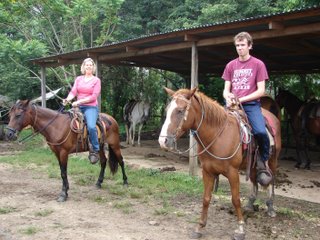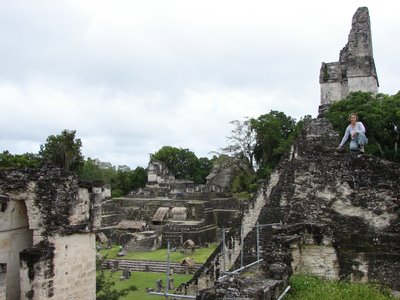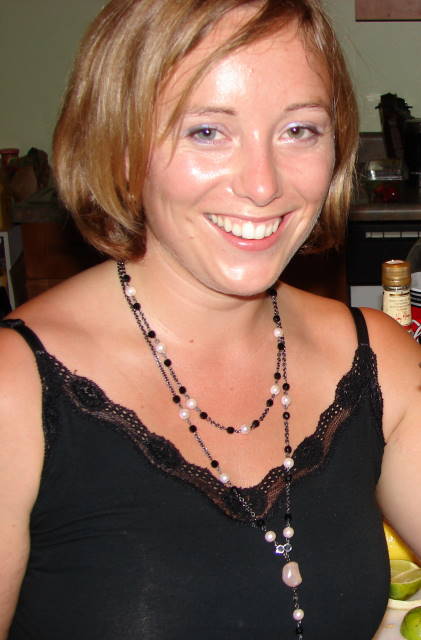From Antigua we drove out East to Quirigua and visited the Mayan ruins for a couple of hours. The main Mayan site in Guatemala is Tikal and the other sites are less touristed so we had the area more less to ourselves. From there we pushed onto Rio Dulce a river and lake area which links onto the Carribean Sea.
Again the views are beautiful, particularly as the river winds towards the sea among jungle, and the people clearly Carribean rather t
 han Mayan or Hispanic. The local people speak a percussive language and many look African. We hired a boat and driver and drove to the port of Livingston, stopping on the way at some thermal springs for a well earned rest after 8 hours on the road.
han Mayan or Hispanic. The local people speak a percussive language and many look African. We hired a boat and driver and drove to the port of Livingston, stopping on the way at some thermal springs for a well earned rest after 8 hours on the road.In Livingston we sampled the local fish soup, Tapado, which has a whole fish, a crab, shrimp and plantains in coconut milk.
The following morning we met our driver to visit Siete Altares, a series of waterfalls and pools where we could swim and jump from the largest waterfall. Here too here were few other tourists and we were free to try all kinds of different diving methods. Sebastian´s back flop was probably the most ill-advised and did not result in the desired photo of him "lying in the air". From the waterfalls we visited some other pints of local interest such as the local Statue of Liberty which locals claim is Martin Luther King but clearly pre-dates him and is white. It is probably a saint of some sort. There is also a 17th cen
 tury fort built by the Spanish to fight the pirates of the area which still stands at the entrance to the lake.
tury fort built by the Spanish to fight the pirates of the area which still stands at the entrance to the lake.From Rio Dulce we headed North towards Tikal but made a stop just over halfway at a hotel which was highly recommended in guide book named Finca Ixobel. Here we were able to go riding with a guide who positively encouraged novices to gallop, eat some fabulous food and enjoy a fireshow in the evening. The receptionist was celebrating her birthday and had invited some friends to come and perform with her. The show was really impressive and we were told that were recently asked to perform in a large televised event.

From the Finca we still had about 4 hours drive to get to Tikal and after an exhausting night of partying I took the opportunity to sleep. When I awoke it was with a start and I was face-down in a puddle with broken glass in it. Since I am not at my most lucid when I have just woken up it took me quite a while to realise that there had been an accident and I was in the bus which was lying on its side. I did not seem to be hurt but needed to find my shoes as there was broken glass everywhere. As I clambered out through the back window and slid past the post we had hit I saw a man lying in the road surrounded by onlookers. He was seriously hurt and had a large cut on his head. Someone had called an ambulance but it would take 40 minutes and although the man was still breathing he clearly needed urgent medical attention. It was a harsh lesson in the culture of the local people when I understood that many were not surprised to see him hurt as he is the village drunk. Many simply did not care, they gossiped and gawped at the latest village attraction. I asked a man "Where is the local doctor?" and he told me that there was a clinic 5 minutes walk away. No one had thought to go there and it wasn´t until I told him to show me the way that we finally ran to get some help. Unfortunately there was no doctor, only nurses, and they were unwilling to get involved. I insisted and one Canadian volunteer eventually stood up to her superiors and insisted that they go. Stephanie was a great help as she stopped the locals from moing the man who was unconscious. There was little to do but wait for the emergency sevices and unfortunately the police came before the ambulance. They simply picked the man up and put him in the back of their truck to drive him to hospital. Meanwhile we checked ourselves for injuries, nothing serious thankfully, and tried to work out what had happened.
The consensus was that we had not hit the man but that he had fallen after being startled by the car and a child who was running after his ball in the road. Our driver, Domingo, had done his best to avoid the people in the road but had lost control on the wet road and the bus had tipped over and hit a post. The bus would now need to stay at the site of the accident and wait for assessment by the insurance company. A Canadian man approached us an offered to help us organise alternative transport to Tikal. He explained that he was the local Menonite pastor.
The pastor lived in the village in which we had crashed with his wife and adopted children. The children come from broken homes or in one case street children with no family at all. As well as running the local church he has established the medical clinic and a school. The family were very welcoming towards us, giving us lemonade and introducing us to visiting relatives while we waited for our new driver. Ishmael arrived and took us in his new bus to Tikal at the sort of speed that people who have just been in an accident like.
At Tikal we got up early to meet our tour guide, at 4.30. We wanted to watch the sun come up and listen to the jungle wake up. The walk through the park in the dark is spooky and we had to take care not to tread on the enormous nocturnal caterpillars which were crawling across the path. The ground was wet and slippery and the sky completely black. Eventually we got to Temple IV, the tallest temple in Meso America, and the place where we would start our visit of Tikal. We experienced another misty sunrise but it was still very beautiful to see the pyramid-shaped temples poking out of the top of the clouds as the sun came up. We then went on a tour of some of the main ruins in the park. The park is huge - hundreds of square kilimeters - and most of it is unexplored and the ruins still covered by jungle. The site, after bien abandonded, was undiscovered fro around 1,000 years. It has been under restoration since the 1880s but progress is slow and there is still a lot of work to do. Looters have damaged some sites as they have pillaged burial grounds for ancient relics. As well as the breathtaking ruins we also saw monkey, macaws and huge trees.

From Tikal we headed Southwest towards Coban and Semuc Champey a stunning National Park. We stayed in a grea riverside hotel and in the morning headed out to visit a local cave. The cave has a river source in it so that water flows through it. We took candels for light and at times swam with one hand to get through the maze of tunnels. Cavers have installed ladders for some of the harder climbs and we were able to cover quite a lot ground in the two hours (although nothing near the 11km to the end of the cave). From the cave we floated down the fast flowing river to the bus and drove to the Semuc Champey National Park but not without the boys jumping off the bridge at around 20 metres above the river. Semuc Champey is a natural bridge and series of clear water pools which covers a very fast flowing river. It was a stunning spot and an ideal place to take our final dip before heading back to Antigua.



